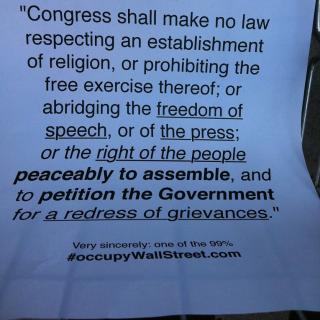Advertisement
It was spring 1970, the world was ablaze with anti-establishment expression: free speech, women’s rights, civil/human rights, anti-war were all movements of the day. On the Ohio State University (https://library.osu.edu/site/dissent/), Kent State (https://www.kent.edu/may-4-1970), and Jackson State (https://www2.kenyon.edu/Khistory/60s/webpage.htm) campuses, like many other campuses across the globe, there was active student rebellion. While the “don’t trust anyone over 30” motif was prevalent, the movement gained support from many communities in Central Ohio, especially OSU students, faculty, and administration. In historic moments, however, the OSU administration had to be challenged to meet student, faculty, and community demands. In 2020, OSU administration was presented with over 500 faculty member signatures concerned by the re-opening of the OSU campus among COVID-19 pandemic and racial justice issues.
Fast forward to Spring 2020 “with all life’s perplexities” (2019 quote by Rev. Dr. Les Stansbery) campuses, nursing homes, prisons, schools, and shops are shutdown. The COVID-19 pandemic has brought economic and social isolation to historic levels. Families dependent on the stock market for their retirements have seen a 30% value reduction in one week (beginning March 13, 2020), where over 1.5 million state and local government jobs have been cut since March 2020 (see https://www.pewtrusts.org/en/research-and-analysis/articles/2020/06/16/how-covid-19-is-driving-big-job-losses-in-state-and-local-government).
From March to June 2020, workers faced 25.3% unemployment (16 to 24 year old, https://www.pewresearch.org/fact-tank/2020/06/11/unemployment-rose-higher-in-three-months-of-covid-19-than-it-did-in-two-years-of-the-great-recession/), which can be compared to the Great Depression (24.3%) and Great Recession (10.4%). As of June 2020, the unemployment rate is still over 11.1%, the gap between Black and white unemployment rates is the "widest in five years," and the Congressional Budget Office is projecting that the unemployment rate will remain above pre-COVID – 19 pandemic levels over the next decade. (See https://cepr.net/jobs-2020-07/, https://news.trust.org/item/20200702150904-zd222/, https://www.cbo.gov/system/files/2020-07/56442-CBO-update-economic-outlook.pdf).
In 1970 it was protest that provoked the establishment leadership to constrict movement and education. As in 1970, students have been sent away from their campus life by myopic leadership who were ill prepared for a pandemic and have only military motif to speak of their response to the current crisis. Public space has been restricted and social networks are constrained by Orwellian explanations that with these policies the corporate state is keeping everyone safe. It was as early as 2015, when politicians were warned about viral pandemic outbreak. In 2020, the same politicians, cry alligator tears as we are at another critical social transformative moment.
Then on Memorial Day 2020, Minneapolis police officers murder George Floyd igniting the latent Black Lives Matter movement with actions in over 2,000 cities. A systemic racial bias had already started to be noticed as the COVID-19 pandemic unequally impacts People of Color (POC), especially Black Americans. “COVID-19 has only served to unmask inequities that have existed for hundreds of years.” (Written by Ana Sandoiuon June 5, 2020 — Fact checked by Catherine Carver, MP, Medical News Today, See at https://www.medicalnewstoday.com/articles/racial-inequalities-in-covid-19-the-impact-on-black-communities)
The current social protest against systemic racism and in support of the Black Lives Matter movement is bringing these inequities into even sharper focus, adding more political and emotional charge to this current movement.
Moreover, the murder of several young Black people during the pandemic hit a raw nerve in the American soul. According to Rob Moore of the Ohio Capital Journal, Ohio is an especially bad offender when it comes to racial disparities in police killings. From 2013 to 2019, the police killed 215 Ohioans, 80 of whom were black. That means over a third (37%) of people killed by police over that time period were black, despite the fact that only 12% of Ohioans as a whole are black according to Census Bureau estimates. This 25-percentage-point disparity makes Ohio a top 10 worst State for racial disparities in police killings and constitutes a bigger disparity than all of its neighboring states. (https://ohiocapitaljournal.com/2020/06/10/race-is-a-big-factor-in-ohio-police-killings/)
As the message of Black Lives Matter is expressed in all corners of the globe, these actions resemble the student rebellions of the late 1960’s and early 1970’s, which prompted many modern day policies and systems meant to address inequalities.
However, Racial, Class, and Gender inequalities remain in place. Vultures, pirates, and privateer capitalists, who are protected by hooligans and vigilante security personnel, ravage the society. The growing discontent is contagious as economic statistics reveal inequalities long experienced by the young and POC sectors of society.
The vanguard of the BLM movement is the young. In the COVID-19pandemic, the Black Lives Matter movement has a unique opportunity to address race and class issues at the same time. The ability of the BLM leadership to apply linkage from the call for Black Lives Matter to political economic liberation is a necessary step forward. Public sector organization is under attack as being the only organized worker voice with strength to help with this linkage. For example, cuts to either state and local government or the Postal Service will disproportionately hurt Black workers. In 2019, either the Postal Service or local and state governments employed nearly 2.6 million Black workers. Between 2017 and 2019, 14% of state and local government workers were Black, as were 26.8% of Postal Service workers," according to Dean Baker and Hayley Brown at the Center for Economic Policy Research (at https://cepr.net/black-workers-jobs-matter/).
The US Congress and Ohio General Assembly must feel the street heat for change. The most pressing work facing Congress is the passing of two bills: the HEROES Act (https://www.congress.gov/bill/116th-congress/house-bill/6800) and the extension of the CARES Act (https://home.treasury.gov/policy-issues/cares). These legislative responses to the current economic crisis represent a thin shield for millions from a depression economy. When the CARES Act expires at the end of July 2020, millions will face economic uncertainty.
As in the 1960’s/1970’s, political identity movements provide cultural outrage to the political agenda, however, sustained change will require the organized worker, the immigrant, and the imprisoned to join the BLM leadership’s outrage together to fight back repression and exclusion.
This rebellion must become a revolution.
This revolution will be televised!




